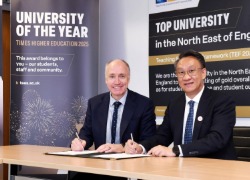Five 'don'ts' after two years of Covid-19
By
Dr Mansoor Soomro
Senior Lecturer, Sustainability and International Business
Recently my research into sustainability in international business has led me to survey 432 business leaders from 16 countries to find out just how much attitudes and practices have changed in the last two years.

The findings show that around 45 percent say the COVID-19 pandemic has resulted in permanent changes to their business models. An even larger 72 percent say the pandemic has helped them to attune their approach to new working habits. What has also emerged from my analysis of the findings is that as we gradually start to hit this new normalcy chord, our focus should be on emerging stronger by avoiding the following five mistakes.
1. Don’t be fixated on one way of working
The pandemic has provided solid evidence that employees working remotely can be as productive as they are in an office. For the same reason, many companies have now rolled out plans to minimise their office real estate and have allowed people to work remotely on a more permanent basis.
“My research shows that 65% of employees enjoy working remotely as compared to working in the office.” – Dr Mansoor
As we move towards the recovery phase, it is imperative that employers don’t backtrack on this trend – particularly if they want to win the new war for talent amid a critical skills shortage that is providing people with much more choice in the job market. In fact they should be going further and exploring the premise of the four-day working week at the same salary – and in particular, how this can improve human resource efficiency, employee satisfaction and competitiveness in recruitment.
Questions you should ask: Can you genuinely offer your employees the flexibility of working remotely, at the office, or in hybrid model? Are leaders in your organisation ready to take on the challenge of a four-day working week?
2. Don’t underestimate the need for training in new technology
Technology has enabled employees to work effectively across different locations in the last two years. Now as we move towards recovery, even more investment is needed in new technology solutions. Companies are already putting more focus on Industry 4.0 technologies like virtual reality, simulations, artificial intelligence as well as various cloud-based technology tools will further improve collaboration and automation at work.
This is encouraging – but the biggest and most common mistake here is not matching investment in new tools with the training required to bring employees up to speed to maximise the benefits. My research has shown the need for upskilling employees on digital technologies has increased five-fold compared with the pre-pandemic times.
Questions you should ask: Which digital capabilities will your organisation focus on in the post-coronavirus future? What training is needed by your employees to function in the new digital environment?
3. Don’t be paralysed by uncertainties
The pandemic forced many companies to think and act faster. Instead of being bogged down by the seemingly insurmountable challenges they became more mobile (moving freely) and agile (moving quickly).
Not all of them though. My research says that 35 percent of leaders admit that their response to the pandemic was slow as they waited long for more and more conclusive data, which in turn led to uncertainty and inaction.
Going forward this can no longer happen if businesses want to survive and thrive – especially if they need to respond to another future crisis. While data for informing decision making is important, businesses must also be more open to being more instinctive and make adjustments before definitive evidence emerges to show that change is needed. Being adaptable is the new, open secret for growth and it means that this kind of mobility and agility will be the new basis for differentiation.
Questions you should ask: Is your business positioned to move freely and quickly to adjust to a new environment? What flexible methods used in pandemic times will you carry over as we recover from the turbulence?
4. Don’t be led by misinformation and disinformation
When there is a lack of information, employers do need to be aware though that the potential for misinformation and disinformation will also increase with a potential negative impact on employees. Disinformation is more deadly as it projects incorrect data, but misinformation is also dangerous as it leads to incorrect decisions and false impressions.
My findings also show over 42 percent of the leaders we surveyed had a fraction of doubt about the various statistics that were projected during the pandemic crisis, including the rate of covid infections,
Recent events have proved that when data is made available there is a great need to fight back against a lack of fact-checking to avoid falling into the trap of misinformation and disinformation. The World Health Organisation summarised this well when it stated that ‘we are not just fighting a pandemic; we are fighting an infodemic’.
Questions you should ask: How do your employees navigate the wave of information? What technology platforms and policies have you promoted for fact-checking and trust-building?
5. Don’t stop those employee wellbeing initiatives
My research shows that 65 percent of executives picked up a new hobby or routine in the pandemic, which consciously or subconsciously was aimed at reducing pandemic stress.
On the organisational level, many employers followed through with this sentiment by initiating various wellbeing programmes focusing on areas like digital detoxes, mindfulness, health, safety, meditation, and resilience.
As we recover from the crisis, and indeed a new cost of living crisis emerges, it is vital that businesses don’t cut back on investment in this area and continue to understand that mental health is equally important as physical health. They also need to recognise that appropriate wellness programmes help employees stay engaged and be more productive. They can also be an important differentiator when people are looking for a new employer.
Questions you should ask: What wellbeing programmes are your organisation focussing on to foster a positive work environment? How can you champion the importance of caring about employees’ wellbeing in way that sets you apart from competitors?
Making sense of the post-COVID business environment is not easy, but being mindful of these five ‘don’ts’ can go a long way towards helping leaders and organisations make sure their recovery is well thought out and doesn’t fall into the trap of losing many of the benefits they have already achieved.
If you would like to engage with the Teesside University International Business School on any of these issues, please get in touch via TUBSBusiness@tees.ac.uk.
 Groundbreaking project to unlock nuclear energy's role in
...
Groundbreaking project to unlock nuclear energy's role in
... Start the new year by expanding your knowledge
Start the new year by expanding your knowledge  Teesside University strengthens long-standing partnership
...
Teesside University strengthens long-standing partnership
...